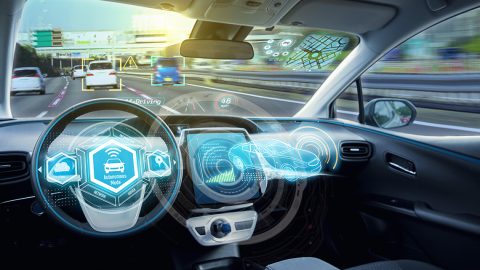
KXDW4W Empty cockpit of autonomous car, HUD(Head Up Display) and digital speedometer. self-driving vehicle.
Self-driving car technology
Self-driving cars are the result of integrating a variety of modern technologies, including lane recognition technology, objects such as traffic lights, other vehicles and pedestrians built on the OpenCV platform. ; Neural Network technology applies machine learning to help the car improve its trajectory by OpenCV recognized; and Integrated Electric Drive Technology using microchips such as Arduino, Raspberry Pi, which helps control the driving process of the vehicle according to the data collected above.
In addition, self-driving cars also use sensor systems, lasers, radars, cameras and GPS technology to analyze objects around the vehicle, thereby reducing the risk of an accident. According to NHTSA and some carmakers have tested cars that can talk to each other. This is car-to-car interaction technology, being tested at GM’s technology center in Warren, Mich. In a large parking lot, GM engineers let the driver run through two cars equipped with GPS technology and a small Wi-Fi transmitter. GPS technology to identify the location and the transmitter so the car can “talk” to other cars. The vehicle alerted the driver when a vehicle braked suddenly in front of you, in a blind spot or approaching from an obscure corner. Unlike radars and cameras, V2V technology does not use light to communicate but transmitters. The cost of the transmitter is cheaper than the hardware used in current safety warning systems.
According to Nady Boule, director of GM Research and Development Center, semi-autonomous vehicles are much better at driving than in many ways. Unlike humans, vehicles can constantly monitor all sides of the vehicle, react almost instantly and cannot be distracted. At the same time driving is also more efficient. A recent study in an American Electronics and Electrical Engineering Academy workshop estimates that a car with sensors increases the ability to drive on highways by 43%. If the cars can talk to each other, this number rises to a staggering 273%.
Unmanned aircraft
Drones is a term used to refer to the types of drones that can be operated remotely or controlled automatically by unmanned vehicles. Drones can capture places where people have not been able to reach, dangerous areas, broadcast sports matches, capture the perspective of animals such as dogs, birds, insects, or real-time broadcast. of VR (virtual reality). In industry, drones can be used to observe production activities in dangerous places, take pre-existing images and detect audio signals to alert incidents, build 3D models for operational objects, etc.
For example, at Ford, the group has started using drones to help carry out the risk test task on Dagenham’s equipment. The company is benefiting greatly from this: The equipment inspection time has been reduced from 12 hours to 12 minutes for each inspection, the risk of occupational safety is also minimized. Not only that, Drone also provides detailed visual documentation of the changes of each device, so that the operator can predict the probable problem and perform preventive maintenance. This significantly saves the organization’s troubleshooting costs.
It can be seen that the application of modern technology has brought tremendous benefits to businesses, not by addition of numbers but by exponentials. The production appearance of enterprises is also changing day by day along with the speed of technology development.